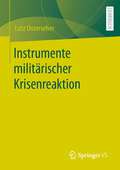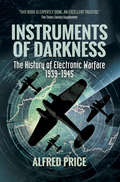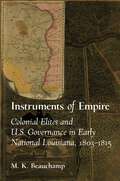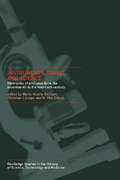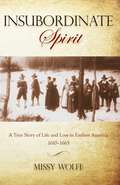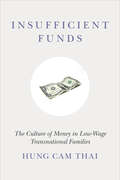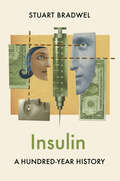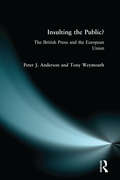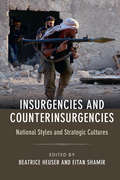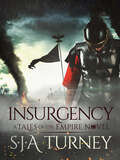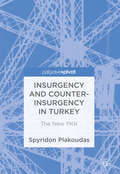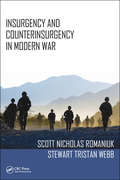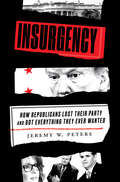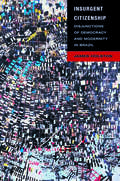- Table View
- List View
Instrumente militärischer Krisenreaktion
by Lutz UnterseherNach den jüngsten Desastern bewaffneter Machtprojektion wird in diesem Buch unternommen, einen rationalen Diskurs über militärische Krisenintervention wiederzubeleben: im Sinne einer stabilitätsorientierten Sicherheitspolitik. Dabei werden Elemente der Landstreitkräfte auf ihre Eignung hin untersucht.
Instruments and their Music in the Middle Ages (Music In Medieval Europe Ser.)
by Timothy J. McGeeThis is a collection of twenty-nine of the most influential articles and papers about medieval musical instruments and their repertory. The authors discuss the construction of the instruments, their playing technique, the occasions for which they performed and their repertory. Taken as a whole, they paint a very broad, as well as detailed, picture of instrumental performance during the medieval period.
Instruments for New Music: Sound, Technology, and Modernism
by Thomas PattesonAt publication date, a free ebook version of this title will be available through Luminos, University of California Press' new Open Access publishing program for monographs. Visit www.luminosoa.org to learn more. Player pianos, radio-electric circuits, gramophone records, and optical sound film--these were the cutting-edge acoustic technologies of the early twentieth century, and for many musicians and artists of the time, these devices were also the implements of a musical revolution. Instruments for New Music traces a diffuse network of cultural agents who shared the belief that a truly modern music could be attained only through a radical challenge to the technological foundations of the art. Centered in Germany during the 1920s and 1930s, the movement to create new instruments encompassed a broad spectrum of experiments, from the exploration of microtonal tunings and exotic tone colors to the ability to compose directly for automatic musical machines. This movement comprised composers, inventors, and visual artists, including Paul Hindemith, Ernst Toch, Jörg Mager, Friedrich Trautwein, László Moholy-Nagy, Walter Ruttmann, and Oskar Fischinger. Patteson's fascinating study combines an artifact-oriented history of new music in the early twentieth century with an astute revisiting of still-relevant debates about the relationship between technology and the arts.
Instruments in the History of Western Music (Routledge Revivals)
by Karl GeiringerOriginally published in 1943 and subsequently as a revised and enlarged edition in 1978, Musical Instruments has long been held in high regard, not only for its erudition, but for its originality of approach. By relating the instruments to their time and each other, epoch by epoch, the author sheds fresh light on their evolution and enables the reader to follow their ups and downs against the changing background of taste and fashion. Each chapter is introduced with an account of the musical forms and artistic trends of the period, before considering in detail the instruments that gave them expression. The reader is carried along, from the magical-sacred beginnings of music, through the instruments of antiquity, the experiments of the Middle Ages and the Renaissance, the refined instruments of the Baroque and classical periods, down to those of the Romantic age and its aftermath, including the modern era with its electronic synthesizers. The book is completed by an Appendix on the acoustics of music and amply illustrated by nearly 100 pictures and diagrams.
Instruments of Darkness
by Imogen RobertsonThe first novel in the Westerman and Crowther historical crime series that The New York Times Book Review called "CSI: Georgian England" and Tess Gerritsen called "chillingly memorable" Debut novelist Imogen Robertson won the London Telegraph's First Thousand Words of a Novel competition in 2007 with the opening of Instruments of Darkness. The finished work is a fast-paced historical mystery starring a pair of amateur eighteenth-century sleuths with razor-sharp minds. When Harriet Westerman, the unconventional mistress of a Sussex manor, finds a dead man on her grounds, she enlists reclusive anatomist Gabriel Crowther to help her find the murderer. Moving from drawing room to dissecting room, from dark London streets to the gentrified countryside, Instruments of Darkness is a gripping tale of the forbidding Thornleigh Hall and an unlikely forensic duo determined to uncover its deadly secrets.
Instruments of Darkness: The History of Electronic Warfare, 1939–1945
by Alfred PriceThe rapid evolution of radio and radar systems for military use during the Second World War, and devices to counter them, led to a technological battle that neither the Axis nor the Allied powers could afford to lose. The result was a continual series of thrusts, parries and counter-thrusts, as first one side then the other sought to wrest the initiative in the struggle to control the ether. This was a battle fought with strange-sounding weapons: 'Freya', 'Mandrel', 'Boozer' and 'Window'; and was characterised by the bravery, self-sacrifice and skill of those who took part in it. However, for many years the use of electronic-warfare systems during the conflict remained a closely guarded military secret. When that veil of secrecy was finally lifted, the technicalities of the subject meant that it remained beyond the reach of lay researchers and readers. Alfred Price, an aircrew officer with the RAF where he flew with V-Force and specialised in electronic warfare and air fighting tactics, was in the unique position to lift the lid on this largely unexplored aspect of the Second World War. When it was first published in 1967, Instruments of Darkness came to be regarded as a standard reference work on this intriguing subject. This completely revised edition concludes with the Japanese surrender in August 1945 and brings the analysis fully up to date in the light of what we now know. 'This book is expertly done. An excellent treatise.' The Times Literary Supplement
Instruments of Embodiment: Costuming in Contemporary Dance (Routledge Advances in Theatre & Performance Studies)
by Eric MullisInstruments of Embodiment draws on fashion theory and the philosophy of embodiment to investigate costuming in contemporary dance. It weaves together philosophical theory and artistic practice by closely analyzing acclaimed works by contemporary choreographers, considering interviews with costume designers, and engaging in practice-as-research. Topics discussed include the historical evolution of contemporary dance costuming, Merce Cunningham’s innovative collaborations with Robert Rauschenberg, and costumes used in Ohad Naharin’s Virus (2001) and in a ground-breaking Butoh solo by Tatsumi Hijikata. The relationship between dance costuming and high fashion, wearable computing, and the role costume plays in dance reconstruction are also discussed and, along the way, an anarchist materialism is articulated which takes an egalitarian view of artistic collaboration and holds that experimental costume designs facilitate new forms of embodied experience and ways of seeing the body. This study will be of great interest to students and scholars working in performance philosophy, philosophy of embodiment, dance and performance studies, and fashion theory.
Instruments of Empire: Colonial Elites and U.S. Governance in Early National Louisiana, 1803–1815
by Michael K. BeauchampM. K. Beauchamp’s Instruments of Empire examines the challenges that resulted from U.S. territorial expansion through the Louisiana Purchase of 1803. With the acquisition of this vast region, the United States gained a colonial European population whose birthplace, language, and religion often differed from those of their U.S. counterparts. This population exhibited multiple ethnic tensions and possessed little experience with republican government. Consequently, administration of the territory proved a trial-and-error endeavor involving incremental cooperation between federal officials and local elites. As Beauchamp demonstrates, this process of gradual accommodation served as an essential nationalizing experience for the people of Louisiana. After the acquisition, federal officials who doubted the loyalty of the local French population and their capacity for self-governance denied the territory of Orleans—easily the region’s most populated and economically robust area—a quick path to statehood. Instead, U.S. officials looked to groups including free people of color, Native Americans, and recent immigrants, all of whom found themselves ideally placed to negotiate for greater privileges from the new territorial government. Beauchamp argues that U.S. administrators, despite claims of impartiality and equality before the law, regularly acted as fickle agents of imperial power and frequently co-opted local elites with prominent positions within the parishes. Overall, the methods utilized by the United States in governing Louisiana shared much in common with European colonial practices implemented elsewhere in North America during the early nineteenth century. While historians have previously focused on Washington policy makers in investigating the relationship between the United States and the newly acquired territory, Beauchamp emphasizes the integral role played by territorial elites who wielded enormous power and enabled government to function. His work offers profound insights into the interplay of class, ethnicity, and race, as well as an understanding of colonialism, the nature of republics, democracy, and empire. By placing the territorial period of early national Louisiana in an imperial context, this study reshapes perceptions of American expansion and manifest destiny in the nineteenth century and beyond. Instruments of Empire serves as a rich resource for specialists studying Louisiana and the U.S. South, as well as scholars of slavery and free people of color, nineteenth-century American history, Atlantic World and border studies, U.S. foreign relations, and the history of colonialism and empire.
Instruments of Empire: Filipino Musicians, Black Soldiers, and Military Band Music during US Colonization of the Philippines
by Mary TalusanAt the turn of the twentieth century, the United States extended its empire into the Philippines while subjugating Black Americans in the Jim Crow South. And yet, one of the most popular musical acts was a band of “little brown men,” Filipino musicians led by an African American conductor playing European and American music. The Philippine Constabulary Band and Lt. Walter H. Loving entertained thousands in concert halls and world’s fairs, held a place of honor in William Howard Taft’s presidential parade, and garnered praise by bandmaster John Philip Sousa—all the while facing beliefs and policies that Filipinos and African Americans were “uncivilized.” Author Mary Talusan draws on hundreds of newspaper accounts and exclusive interviews with band members and their descendants to compose the story from the band’s own voices. She sounds out the meanings of Americans’ responses to the band and identifies a desire to mitigate racial and cultural anxieties during an era of overseas expansion and increasing immigration of nonwhites, and the growing “threat” of ragtime with its roots in Black culture. The spectacle of the band, its performance and promotion, emphasized a racial stereotype of Filipinos as “natural musicians” and the beneficiaries of benevolent assimilation and colonial tutelage. Unable to fit Loving’s leadership of the band into this narrative, newspapers dodged and erased his identity as a Black American officer. The untold story of the Philippine Constabulary Band offers a unique opportunity to examine the limits and porousness of America’s racial ideologies, exploring musical pleasure at the intersection of Euro-American cultural hegemony, racialization, and US colonization of the Philippines.
Instruments, Travel and Science: Itineraries of Precision from the Seventeenth to the Twentieth Century (Routledge Studies in the History of Science, Technology and Medicine)
by H. Otto Sibum Marie-No X00EB Lle Bourguet Christian LicoppeWe are now accustomed to conceive of science as an instrumental activity, producing numbers, measurements and graphs by means of sophisticated devices. This book investigates the historical process that gave rise to this instrumental culture. The contributors trace the displacement of instruments across the globe, the spread of practices or precision and the circulation and appropriation of skills and knowledge. Through comparative and contextual approaches, the volume confronts the tension between the local and the global, examining the process of the universalization of science. Bringing together case studies ranging from the seventeenth to the twentieth centuries, contributors discuss French, German and British initiatives, as well as the knowledge and techniques of travellers in countries such as India, Africa, South East Asia and the Americas. Students and researchers interested in the history of science in both Western and non-Western cultures will find this book a valuable and thought-provoking read.
Insubordinate Costume: Inspiring Performance
by Susan MarshallInsubordinate Costume: Inspiring Performance presents a comprehensive study of historical and contemporary examples of scenographic costume – the type of costume that creates an almost complete stage environment by itself, simultaneously acting as costume, set and performance.This book provides readers with an overview of the costumes, designers, context and theory that have contributed to the emerging field of ‘costume as performance’. Focusing on artists and their creative approach to space, form, materials and movement, the book looks at iconic figures such as Loïe Fuller, Oskar Schlemmer and Leigh Bowery, amongst contemporary examples of practitioners that are blurring disciplinary boundaries between fashion, dance, performance and theatre. The book includes chapters by Dr Sofia Pantouvaki, who focuses on performance costume as a means of research; Christina Lindgren, who presents the findings of the four-year Costume Agency project at Oslo National Academy of the Arts in Norway; Charlotte Østergaard, who discusses the implications of 'Listening with costume' and Felix Choong, writing on 'Contemporary Runways, Contemporary Costumes'. The final part of the volume, 'The Practitioners’ Voice', examines current practice through interviews and contributions from key practitioners with an afterword by Dr Rachel Hann.Insubordinate Costume will appeal to professional costume designers, performance artists, dancers, directors, choreographers, fashion designers and theorists, teachers and students of these subjects. With its interdisciplinary focus and unique and dynamic content, this publication is relevant to a range of art, design and performance courses.
Insubordinate Spirit: A True Story of Life and Loss in Earliest America 1610-1665
by Missy WolfeInsubordinate Spirit is a unique exploration into the life of Elizabeth Winthrop and other seventeenth-century English Puritans who emigrated to the rough, virtually untouched wilderness of present-day New England. Excerpts from newly discovered personal diaries and correspondence provide readers with not only fascinating insights into the hardships, dangers, and losses inherent to English and Dutch settlers in the 1600s, but also first-hand descriptions of the local Native Americans' family life, allegiances, and society. Caught between the unendurable expectations of her Puritan relatives and land disputes with the neighboring Dutch, Elizabeth Winthrop demonstrated a tremendous strength of resolve to protect her own family and remain true to her heart.
Insufficient Funds: The Culture of Money in Low-Wage Transnational Families
by Hung Cam ThaiEvery year migrants across the globe send more than $500 billion to relatives in their home countries, and this circulation of money has important personal, cultural, and emotional implications for the immigrants and their family members alike. Insufficient Funds tells the story of how low-wage Vietnamese immigrants in the United States and their poor, non-migrant family members give, receive, and spend money. Drawing on interviews and fieldwork with more than one hundred members of transnational families, Hung Cam Thai examines how and why immigrants, who largely earn low wages as hairdressers, cleaners, and other "invisible" workers, send home a substantial portion of their earnings, as well as spend lavishly on relatives during return trips. Extending beyond mere altruism, this spending is motivated by complex social obligations and the desire to gain self-worth despite their limited economic opportunities in the United States. At the same time, such remittances raise expectations for standards of living, producing a cascade effect that monetizes family relationships. Insufficient Funds powerfully illuminates these and other contradictions associated with money and its new meanings in an increasingly transnational world.
Insular Destinies: Perspectives on the history and politics of modern Cyprus (British School at Athens - Modern Greek and Byzantine Studies #8)
by Paschalis KitromilidesIn this collection, an eminent authority on the history of political thought and on the intellectual history of modern Hellenism employs his twin academic specializations in political science and in intellectual history to understand the intricacies of the historical experience of his native island. Writing in a perspective inspired by the work of Fernand Braudel, he attempts in a series of studies in cultural and social history to recover lost and overlooked aspects of the collective destinies of Cyprus and the Cypriot diaspora in the centuries of Ottoman rule, a period of critical significance for the survival of the people of the island. He then turns to a penetrating analysis of the politics of the Cyprus Question. The pertinent studies collected in this volume bear the imprint of the deep soul-searching by the younger generation of Cypriot scholars at the time of the tragedy of 1974 over what went so wrong that their country was exposed to foreign invasion, occupation and division. The hints at answers to these questions offered by the author’s interdisciplinary and critical treatment of the subject make this work an indispensable aid to anyone wishing to grasp the deeper antinomies and dilemmas immanent in the Cyprus Question.
Insulin: A Hundred-Year History (History of Health and Illness)
by Stuart BradwelIn 1922, an unlikely team of researchers in Toronto made one of the most important medical breakthroughs of the century: insulin. Their discovery seemed miraculous. When it was given to diabetic patients on the brink of death, their condition rapidly improved. Those present could barely believe their eyes: they had witnessed resurrection. However, this was no simple cure. Injections must be taken for life. Without them, symptoms quickly return, often with fatal results. But while a lifetime on insulin poses great challenges, it also offers opportunities. In this revelatory history, Stuart Bradwel looks back on one of medicine’s most celebrated innovations. Setting professional narrative against subjective patient experience, he tells the story of a drug that has challenged many of the basic assumptions upon which medical practice is built, both inside and outside the clinic. Nevertheless, Bradwel reminds us that the centenary of this apparent “wonder drug” should be no cause for celebration. Insulin often remains inaccessible to those who need it most: elusive prescriptions, uneven availability and sky-high prices result in rationing and desperate do-it-yourself research and development. In the face of bootstraps rhetoric and “Pharma Bro” capitalists, patients across the world are left to fend for themselves. There is a long way to go in the twenty-first century until insulin truly fulfils the extraordinary promises made by its discovery.
Insulting the Public?: The British Press and the European Union
by Tony Weymouth Peter J. AndersonInsulting the Public? examines the way in which the European Union and issues relating to it are represented to the public. Combining theoretical and empirical research, the text explores and provides an assessment of the performance of the British Press in its representation of the European Union in the period immediately preceding the General Election of 1997 and during the British presidency of the Union from January to June 1998.
Insurance Era: Risk, Governance, and the Privatization of Security in Postwar America
by Caley HoranCharts the social and cultural life of private insurance in postwar America, showing how insurance institutions and actuarial practices played crucial roles in bringing social, political, and economic neoliberalism into everyday life. Actuarial thinking is everywhere in contemporary America, an often unnoticed byproduct of the postwar insurance industry’s political and economic influence. Calculations of risk permeate our institutions, influencing how we understand and manage crime, education, medicine, finance, and other social issues. Caley Horan’s remarkable book charts the social and economic power of private insurers since 1945, arguing that these institutions’ actuarial practices played a crucial and unexplored role in insinuating the social, political, and economic frameworks of neoliberalism into everyday life. Analyzing insurance marketing, consumption, investment, and regulation, Horan asserts that postwar America’s obsession with safety and security fueled the exponential expansion of the insurance industry and the growing importance of risk management in other fields. Horan shows that the rise and dissemination of neoliberal values did not happen on its own: they were the result of a project to unsocialize risk, shrinking the state’s commitment to providing support, and heaping burdens upon the people often least capable of bearing them. Insurance Era is a sharply researched and fiercely written account of how and why private insurance and its actuarial market logic came to be so deeply lodged in American visions of social welfare.
Insurgencies and Counterinsurgencies: National Styles And Strategic Cultures
by Beatrice Heuser Eitan ShamirThis book is a major new study of the extent to which national mentalities, or 'ways of war', are responsible for 'national styles' of insurgency and counterinsurgency. Leading scholars examine the ways of war of particular insurgent movements, and the standard operational procedures of states and occupation forces to suppress them. Through case studies ranging from British, American and French counterinsurgency to the IRA and the Taliban, they show how 'national styles' evolve, influenced by transnational trends, ideas and practices. They examine whether we can identify a tendency to resort to a particular pattern of fighting and, if so, whether this is dictated by constants such as geography and climate, or by the available options, or else whether there exists a particular 'strategic culture' or 'national style'. Their findings show that 'national style' is not eternal but can undergo fundamental transformations.
Insurgency (Tales of the Empire)
by S.J.A. TurneyA forbidden love. A daring escape. A gathering storm.Forty years have passed since the Empire was restored. Emperor Kiva the Golden, his wife Jala Parishid, and his brother Marshal Quintillian have together overseen decades of peace and prosperity, a time when the horrors of the civil war could begin to fade from memory.But nothing can last forever. A forbidden love drives Quintillian from the capital far into the eastern deserts, where he discovers an unprecedented threat to the Empire’s very survival. And when Jala is kidnapped by a sinister and ruthless group of warriors, it will take all of Kiva’s strength to defend her, his people, and their destiny…Set in a world inspired by Roman history, Insurgencyis a sweeping tale of deception, cunning, and military valour, ideal for readers of Matthew Harffy, Simon Scarrow, and K. M. Ashman.
Insurgency In Ancient Times: The Jewish Revolts Against The Seleucid And Roman Empires, 166 BC-73 AD
by LTC William T. SorrellsThis monograph examines two insurgencies conducted by the Jews in ancient times: The Maccabee Revolt against the Seleucid Empire from 166-164 BC and the Revolt against the Roman Empire from 66-70 AD. The monograph proposes that all insurgencies have a nature and the nature of insurgency is as critical to understanding an insurgency today as it was two thousand years ago. Ancient Jewish history provides an excellent case study of a successful and failed insurgency. The Jewish revolt against the Seleucid Empire (Maccabee Revolt 166-164 BC) was a successful insurgency, which gained the free practice of religion for the Jewish people and ultimately an independent Jewish State. This independence lasted for one hundred years until 63 BC when Palestine was annexed by the Roman Empire. Subsequently, the Jewish people again revolted in 66 AD against Roman rule, but the result of the insurgency was a failure catastrophic to the Jewish people and the prospects for an independent Jewish state.The monograph contains four sections: Introduction, Prelude and Nature of Insurgency: The Maccabee Revolt, Prelude and Nature of Insurgency: The Revolt against Rome, and Conclusion. The model for analysis is the nature of insurgency as defined by US Army Doctrine. The respective natures of each insurgency are each examined separately to provide data for analysis. The data for each insurgency is then compared against the other to determine why one insurgency failed and the other succeeded.
Insurgency Trap: Labor Politics in Postsocialist China
by Eli FriedmanDuring the first decade of the twenty-first century, worker resistance in China increased rapidly despite the fact that certain segments of the state began moving in a pro-labor direction. In explaining this, Eli Friedman argues that the Chinese state has become hemmed in by an "insurgency trap" of its own devising and is thus unable to tame expansive worker unrest. Labor conflict in the process of capitalist industrialization is certainly not unique to China and indeed has appeared in a wide array of countries around the world. What is distinct in China, however, is the combination of postsocialist politics with rapid capitalist development.Other countries undergoing capitalist industrialization have incorporated relatively independent unions to tame labor conflict and channel insurgent workers into legal and rationalized modes of contention. In contrast, the Chinese state only allows for one union federation, the All China Federation of Trade Unions, over which it maintains tight control. Official unions have been unable to win recognition from workers, and wildcat strikes and other forms of disruption continue to be the most effective means for addressing workplace grievances. In support of this argument, Friedman offers evidence from Guangdong and Zhejiang provinces, where unions are experimenting with new initiatives, leadership models, and organizational forms.
Insurgency and Counter-Insurgency in Turkey: The New Pkk
by Spyridon PlakoudasThis book seeks to answer the “why” and “how” questions about the insurgency of the PKK, a militant left-wing group of Turkey’s Kurds, in Turkey. The PKK has been inter-locked in an intermittent war against Turkey since 1984 in the name of Kurdish nationalism. The author combines insights of Strategy and IR - from strategy and tactics in irregular warfare to peace negotiations between state authorities and insurgents, with data from qualitative research, to achieve two inter-related objectives: first, assess the current state of affairs and predict the future course of the conflict and, secondly, draw general conclusions on how protracted conflicts can end and how.
Insurgency and Counterinsurgency in Modern War
by Scott Nicholas Romaniuk Stewart Tristan WebbA collection of original works covering all aspects of insurgency and counterinsurgency through a multinational lens, Insurgency and Counterinsurgency in Modern War addresses the need to look beyond the United States and other prominent counterinsurgency actors in the contemporary world. It addresses the need to look beyond the United States and other preeminent counterinsurgency actors in the contemporary world while reassessing some of the latent and burgeoning insurgent organizations and networks around the globe. It also suggests alternative approaches to understanding insurgency, counterinsurgency, and conventional and asymmetric warfare as they relate to insurgency and counterinsurgency.
Insurgency: How Republicans Lost Their Party and Got Everything They Ever Wanted
by Jeremy W. PetersHow did the party of Lincoln become the party of Trump? From an acclaimed political reporter for The New York Times comes the definitive story of the mutiny that shattered American politics.&“A bracing account of how the party of Lincoln and Reagan was hijacked by gadflies and grifters who reshaped their movement into becoming an anti-democratic cancer that attacked the U.S. Capitol.&”—Joe ScarboroughJeremy W. Peters&’s epic narrative chronicles the fracturing of the Republican Party. Insurgency is a fantasia-like story of a party establishment that believed it could control the dark energy it helped foment—right up until it suddenly couldn&’t. How, Peters asks, did conservative values that Republicans claimed to cherish, like small government, fiscal responsibility, and morality in public service, get completely eroded as an unshakable faith in Donald Trump grew to define the party?The answer is a tale traced across three decades—with new reporting and firsthand accounts from the people who were there—of populist uprisings that destabilized the party. The signs of conflict were plainly evident for anyone who cared to look. After Barack Obama&’s election convinced many Republicans that they faced an existential demographics crossroads, many believed the only way to save the party was to create a more inclusive and diverse coalition. But party leaders underestimated the energy and popular appeal of those who would pull the party in the opposite direction. They failed to see how the right-wing media they hailed as truth-telling was warping the reality in which their voters lived. And they did not understand the complicated moral framework by which many conservatives would view Trump, leading evangelicals and one-issue voters to shed Republican orthodoxy if it delivered a Supreme Court that would undo Roe v. Wade.In this sweeping history, Peters details key junctures and episodes to unfurl the story of a revolution from within. Its architects had little interest in the America of the new century but a deep understanding of the iron will of a shrinking minority. With Trump as their polestar, their gamble paid greater dividends than they&’d ever imagined, extending the life of far-right conservatism in United States domestic policy into the next half century.
Insurgent Citizenship: Disjunctions Of Democracy And Modernity In Brazil (In-formation Ser.)
by James Holston<P>Insurgent citizenships have arisen in cities around the world. <P>This book examines the insurgence of democratic citizenship in the urban peripheries of São Paulo, Brazil, its entanglement with entrenched systems of inequality, and its contradiction in violence.<P> James Holston argues that for two centuries Brazilians have practiced a type of citizenship all too common among nation-states--one that is universally inclusive in national membership and massively inegalitarian in distributing rights and in its legalization of social differences.<P> But since the 1970s, he shows, residents of Brazil's urban peripheries have formulated a new citizenship that is destabilizing the old.<P> Their mobilizations have developed not primarily through struggles of labor but through those of the city--particularly illegal residence, house building, and land conflict. <P>Yet precisely as Brazilians democratized urban space and achieved political democracy, violence, injustice, and impunity increased dramatically.<P> Based on comparative, ethnographic, and historical research, Insurgent Citizenship reveals why the insurgent and the entrenched remain dangerously conjoined as new kinds of citizens expand democracy even as new forms of violence and exclusion erode it.<P> Rather than view this paradox as evidence of democratic failure and urban chaos, Insurgent Citizenship argues that contradictory realizations of citizenship characterize all democracies--emerging and established. <P>Focusing on processes of city- and citizen-making now prevalent globally, it develops new approaches for understanding the contemporary course of democratic citizenship in societies of vastly different cultures and histories.
